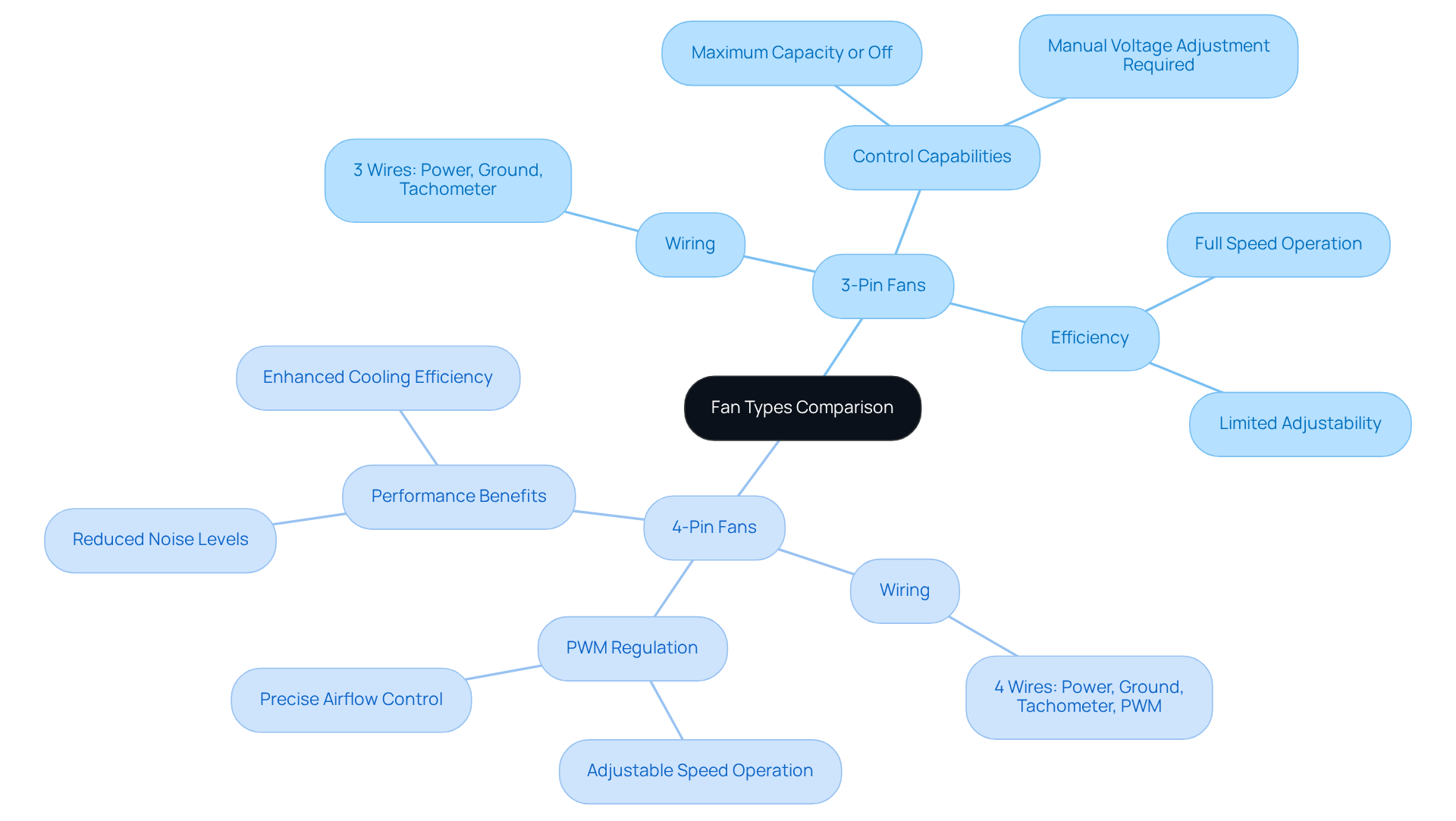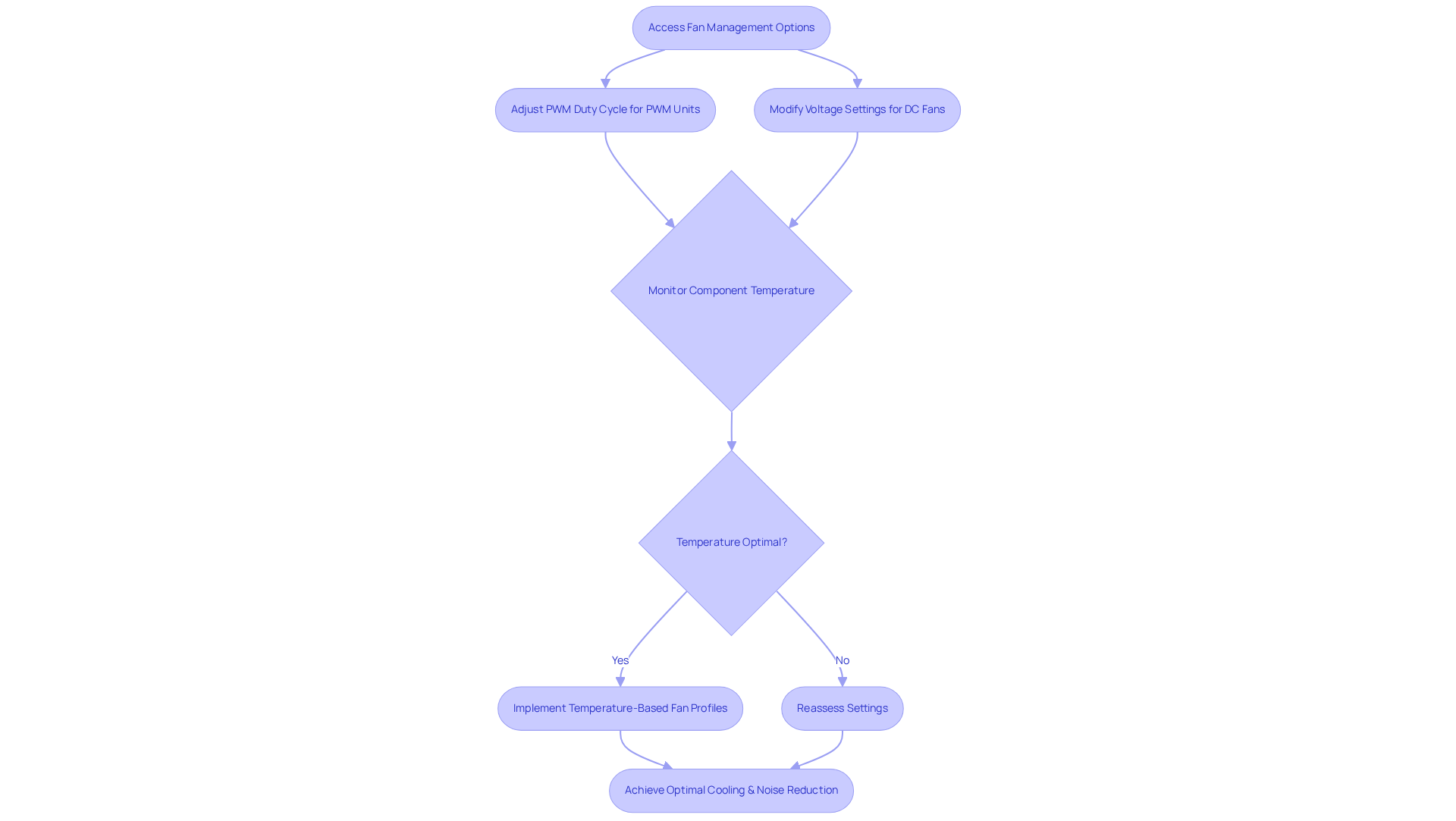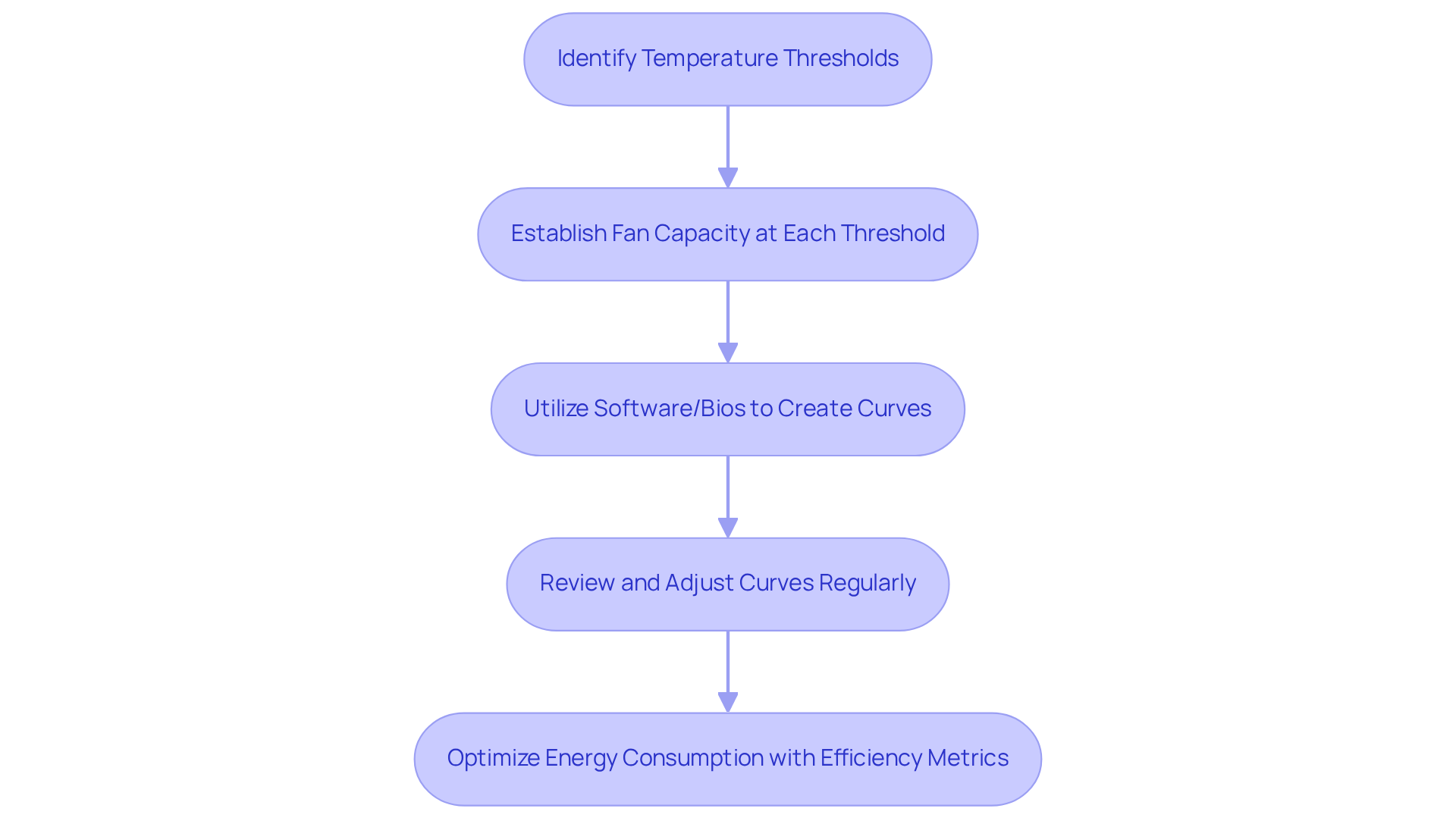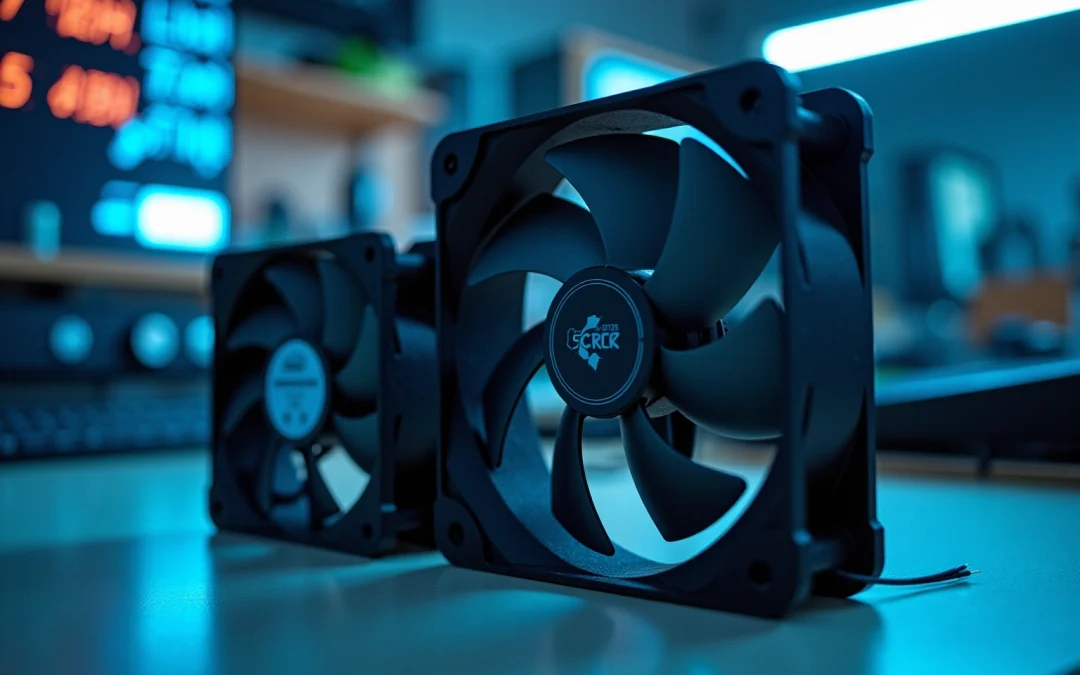Overview
This article delves into the customization of high temperature blower settings to achieve optimal performance. By employing fan control methods such as Pulse Width Modulation (PWM) and Direct Current (DC) fan management, users can significantly enhance their systems. PWM, in particular, provides precise control over fan speed and efficiency, leading to reduced noise and lower energy consumption. Furthermore, it is crucial to adjust fan settings according to temperature profiles, which not only improves cooling effectiveness but also minimizes operational costs. This strategic approach ensures that systems operate at peak performance while maintaining cost efficiency.
Introduction
Understanding the intricacies of fan control is essential for enhancing the performance of high-temperature blowers, a necessity across various industrial applications. This article explores the critical methods of Pulse Width Modulation (PWM) and Direct Current (DC) fan control, demonstrating how these techniques optimize airflow while minimizing noise.
The choice between 3-pin and 4-pin fans presents a challenge, as does the customization of settings for maximum efficiency. Thus, engineers face the imperative task of striking the perfect balance between cooling power and operational sound.
Understand PWM and DC Fan Control Methods
Pulse Width Modulation (PWM) and Direct Current (DC) fan management methods are critical techniques for regulating fan speed in electronic systems. , allowing for precise control over the average power supplied to the fan. This approach not only , making it particularly suitable for applications where noise is a concern. Engineers recognize PWM as an invaluable tool for balancing airflow and sound, dynamically adapting to cooling demands across various sectors, including:
- Automotive
- Telecom
- Consumer electronics
Conversely, modifies the voltage supplied to the fan, which can result in . Although DC systems are generally more cost-effective and straightforward, they lack the precise control that PWM offers, often leading to heightened sound levels during operation. For instance, reducing fan speed by 25% can yield a 60% decrease in power consumption and a sound reduction of approximately 6 dB, illustrating the non-linear relationship between fan speed and sound.
Recent advancements in have further improved its efficiency, enabling up to a 30% reduction in power consumption compared to DC devices while maintaining equivalent cooling effects. , offers a , optimized for performance and low noise, catering to various industrial applications. Understanding these is crucial for enhancing the efficiency of the , as they directly impact airflow handling and temperature management.

Differentiate Between 3-Pin and 4-Pin Fans
3-pin and s primarily differ in their control capabilities, a distinction critical for . A consists of three wires: one for power, one for ground, and one for the tachometer signal, which indicates the . This configuration limits the fan’s operation to maximum capacity or off, thereby restricting its efficiency. In contrast, a 4-pin fan incorporates an additional wire for , allowing for . This feature facilitates precise adjustments to airflow and noise levels, making 4-pin fans the preferred choice for applications that demand fine-tuned performance. Understanding the in use is essential when adjusting , as it enables effective management and optimization of system performance.

Customize Fan Speed Settings for Efficiency
To enhance efficiency in fan rate settings, initiate by accessing the within your system’s BIOS or software interface. For PWM units, adjusting the is crucial; a lower duty cycle reduces the , whereas a higher duty cycle increases it. For those utilizing DC fans, modifying the voltage settings is essential to achieve the desired pace.
It is advisable to monitor the being cooled to establish an . Notably, statistics reveal that a 10% reduction in RPM leads to a 19% decrease in static pressure, underscoring the significance of meticulous adjustments.
Additionally, consider implementing , such as configuring fan rotations to 700 RPM at temperatures between 40-59°C. This strategy allows for automatic in response to system temperature, ensuring effective cooling while minimizing noise.
According to the US Department of Energy, can yield of up to 50%. These adjustments not only enhance system reliability but also contribute to reduced operational costs.

Implement Example Fan Curves for Optimal Performance
To effectively implement example fan curves, start by identifying the . For instance, you might establish a curve where the fan operates at 30% capacity at 30°C, increases to 50% at 50°C, and reaches maximum performance at 70°C.
Utilizing software tools or BIOS settings can facilitate the creation of these curves, enabling a gradual increase in in response to temperature changes. This method not only but also reduces sound levels during low-load scenarios.
Regularly reviewing and adjusting these curves based on system performance and thermal requirements is crucial for maintaining . By mastering , engineers can ensure efficient fan operation without excessive noise, which is particularly vital in sensitive environments such as consumer electronics and medical devices.
Understanding fan efficiency metrics, including the operating point where a fan utilizes 20 brake horsepower, is essential for optimizing energy consumption. Furthermore, the blower energy index serves as a valuable tool for selecting , further enhancing the effectiveness of your .
Insights from case studies, such as ‘,’ underscore the importance of comprehending the relationship between variable speed fans and fan curves, leading to significant improvements in energy management and performance evaluation.

Conclusion
Optimizing high temperature blower settings is essential for achieving peak performance and energy efficiency across various applications. Understanding the differences between PWM and DC fan control methods, as well as the distinctions between 3-pin and 4-pin fans, empowers users to make informed decisions that enhance airflow management and reduce noise levels. Customizing fan speed settings and implementing effective fan curves are crucial strategies for maintaining optimal cooling while minimizing energy consumption.
Key insights discussed include:
- The advantages of PWM technology over DC regulation, particularly regarding energy savings and noise reduction.
- The importance of adjusting fan settings based on temperature thresholds and system demands, demonstrating how a strategic approach can lead to significant operational cost reductions.
- The implementation of temperature-based fan profiles and example fan curves, providing a roadmap for achieving efficient cooling in sensitive environments.
Ultimately, mastering blower performance settings not only enhances system reliability but also contributes to sustainability efforts by reducing energy waste. Engineers and technicians are encouraged to leverage these insights and techniques, ensuring that their cooling solutions are both effective and environmentally friendly. By prioritizing optimal fan performance, users can achieve a balance between efficiency and functionality, paving the way for improved thermal management in high-temperature applications.
Frequently Asked Questions
What are Pulse Width Modulation (PWM) and Direct Current (DC) fan control methods?
PWM and DC fan control methods are techniques used to regulate fan speed in electronic systems. PWM controls fan speed by rapidly switching the fan on and off, allowing precise power control, while DC regulation adjusts the voltage supplied to the fan.
How does PWM enhance energy efficiency?
PWM enhances energy efficiency by allowing for precise control over the average power supplied to the fan, which reduces power consumption and minimizes sound levels.
In which sectors is PWM particularly useful?
PWM is particularly useful in various sectors, including automotive, telecom, and consumer electronics, where balancing airflow and sound is essential.
What are the drawbacks of DC fan regulation?
DC fan regulation can result in less efficient operation and increased heat generation. It also lacks the precise control that PWM offers, often leading to higher sound levels during operation.
How does reducing fan speed affect power consumption and sound levels?
Reducing fan speed by 25% can lead to a 60% decrease in power consumption and a sound reduction of approximately 6 dB, highlighting the non-linear relationship between fan speed and sound.
What advancements have been made in PWM technology?
Recent advancements in PWM technology have improved its efficiency, enabling up to a 30% reduction in power consumption compared to DC devices while maintaining equivalent cooling effects.
Who is Gagner-Toomey Associates and what do they offer?
Gagner-Toomey Associates is the world’s largest producer of standard and custom air-movers. They offer a diverse array of DC input Tube Axial units and Centrifugal Blowers optimized for performance and low noise, catering to various industrial applications.
Why is understanding PWM and DC fan control methods important?
Understanding these management techniques is crucial for enhancing the efficiency of high-temperature blowers, as they directly impact airflow handling and temperature management.

